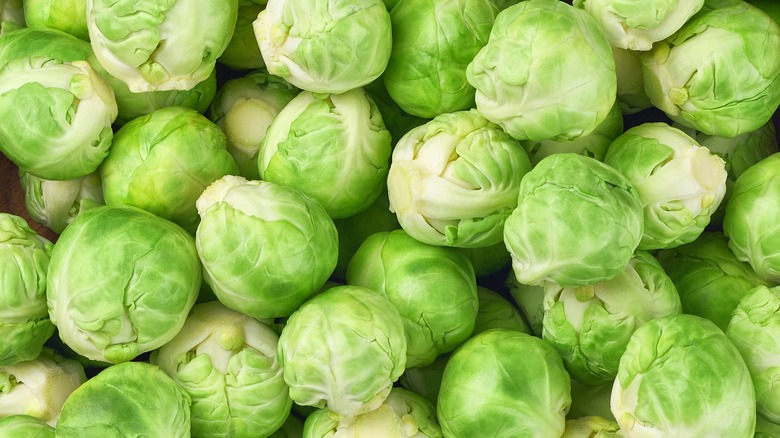How Roasting Was Responsible For The Brussels Sprout Renaissance
If you are over a certain age, there are some vegetables you absolutely hated as a kid and may still dislike today. You may have been so scarred by the experience that you won't eat certain vegetables as an adult. The prime candidate for this visceral reaction is the Brussels sprout, according to a study conducted by Heinz in 2008, per Boston Organics.
Children of that era likely remember being forced to sit at the table, staring unhappily at the lurid green little globes, knowing that every bite would be unimaginably bitter (they were even worse if you were a bitter supertaster, according to Scientific American). Kids could try to hide them in a napkin or perhaps slip them to the dog, often to no avail. Failing any other option, they likely sat there stubbornly until their moms gave up.
Amazingly, so many of those grown-up children now love Brussels sprouts. When prepared properly, as in this recipe for burnt Brussels sprouts, they are sweet and slightly crisp with a chewy texture and nutty flavor. People will happily eat them any day of the week. How on earth did this happen? Two answers: horticulture and the cooking method.
Genetics and Cooking
In the 1960s, which may have been the peak Brussels sprouts hating period, many farmers transitioned from hand harvesting the little cabbages to mechanical harvesting. That meant they needed a plant where the sprouts would mature at about the same time, farmer Steve Bontadelli told Mel Magazine.
The problem: those efficient plants produced bitter little sprouts. According to a 1999 study in The Science of Food and Agriculture, the compounds that make the sprouts so bitter are the glucosinolates sinigrin and progoitrin. Sound ominous, don't they?
When the sprouts are sliced or cut in half or trimmed, the cell walls are damaged, which releases an enzyme that breaks down the glucosinolate compounds, producing a bitter flavor and sulfurous smell, according to the Harvard School of Public Health. Then there was the preparation method. Older cookbooks all advised their readers to boil or steam Brussels sprouts, which concentrated the flavors without adding anything else, and the texture became mushy. Not a good combination.
Science to the rescue!
According to Produce Processing, horticulturists started to take notice. About 7,000 acres devoted to Brussels sprouts in 1960s California fell to as low as 2,200 acres in the decades after. In the '90s, researchers in Holland (not Belgium, surprisingly enough) started looking for vintage seeds with fewer glucosinolates that could be cross-bred with plants with a similar maturation rate, per The Salt. And they found it. Now there are 10,000 acres devoted to Brussels sprouts in California alone.
Then restaurants started roasting and even deep frying the sprouts, according to Mental Floss. This dry heat started the Maillard reaction, which produces sweet and flavorful compounds to help override the bitter, sulfurous tastes and aromas. And adding other ingredients, too, like bacon or garlic, provides even more incredible flavor. Roasting is also great for texture. Roasted sprouts are crispy on the outside and tender and chewy on the inside. What's not to love?
Besides, these tiny cabbages are good for you. According to a study published in Molecular Nutrition and Food Research, Brussels sprouts protect against cellular DNA damage, which can help reduce cancer risk. So for dinner tonight, give Brussels sprouts a try again and make crispy Brussels sprouts, roasted Brussels sprouts with bacon, or maple-Dijon Brussels sprouts.


